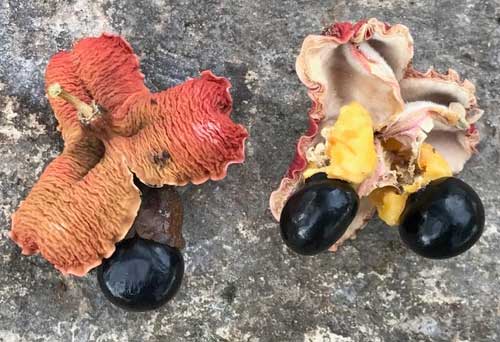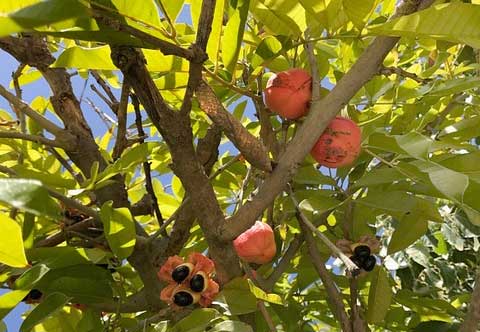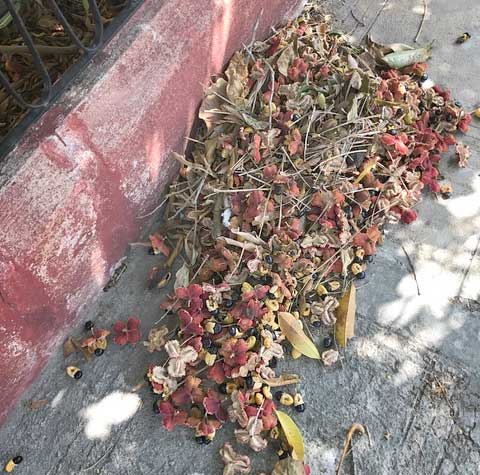Excerpts from Jim Conrad's
Naturalist Newsletter
from the March 12, 2017 Newsletter issued from Rancho Regenesis in the woods ±4kms west of Ek Balam Ruins; elevation ~40m (~130 ft), N20.876°, W88.170°; north-central Yucatán, MÉXICO
ACKEE FRUITS ON A TREE IN MÉRIDA
This week I visited Mérida for my final checkup after my eye operation. While there I enjoyed some quality time with my old park-sitting buddies. One morning my friend Eric arrived at the park carrying a blue plastic bag filled with unusual fruits he'd found beneath a tree next to a sidewalk a few blocks away. When I expressed interest, Eric set a couple of fruits on the wall of a nearby fountain and took the picture shown below:

Those opened-up fruits are about 2½ inches across (6cm) at their widest, the black seeds being 5/8-inch long (17mm). They are capsule-type fruits, meaning that they're dry pods developed from a flower's ovary divided into two or more compartments, or carpels, and the pod splits along one or more suture-like "lines of dehiscence." The fruits in the picture split along three lines causing the surprisingly hard, almost woody covering to split into three parts.
Inside the fruit, the hard, black seeds are embraced at their bases by soft, gummy, yellow growths known as arils. When fruits produce such seeds associated with eye-catching arils, it can be understood that the arils probably draw the attention of animals who will eat it, in the process spreading the seeds into new territory. In short, these fruits display a beautiful seed-dispersal mechanism.
Later Eric supplied more pictures, including one showing open and unopened fruits still hanging on the tree, shown below:

In that picture you can barely make out that the tree's leaves are pinnately compound, with four or five pairs of leaflets. The tree, about ten feet tall (3m), was fruiting prodigiously and dropping the fruits onto the sidewalk, necessitating the property owner to sweepnthem into a pile, as Eric's picture shows below:

With such unusual, aril-producing, capsular fruits it was easy to determine the plant family the tree belonged to, and then to identify the tree. It's the Soapberry Family, the Sapindaceae, a family of tropical and subtropical trees. Soapberry Family members you might know include the Soapberry, the Guaya or Spanish-Lime whose fruits are much eaten in the Yucatan, Litchi, the Balloon-Vine, and the Goldenrain-Tree. But Eric's sidewalk tree is none of those.
It's BLIGHIA SAPIDA, usually known as the Ackee. The genus Blighia is named for the famous Captain Bligh, commander of the English ship "Bounty." Blighia sapida is such an unusual plant that it's the only species in the genus Blighia. Ackee is native to western Africa but is grown in the tropics worldwide for its edible fruit, and maybe for its novelty.
Ackee often is associated with Jamaica because there the tree's fleshy aril is collected and made into a local dish that enjoys international fame. Ackee products are an important export item for Jamaica.
Despite the aril's edibility, the black seeds are highly toxic. Still, the plan here is to plant the seeds, grow some Ackee trees like those in Mérida, and someday prepare our own good-tasting meals with them. If the seeds sprout, you'll learn more about Ackee in the future.
from the April 23, 2017 Newsletter issued from Rancho Regenesis in the woods ±4kms west of Ek Balam Ruins; elevation ~40m (~130 ft), N20.876°, W88.170°; north-central Yucatán, MÉXICO
ACKEE SEEDS SPROUTING
Several months before the above was written, Eric had collected seed-bearing Ackee fruits in Mérida, given them to me, and the seeds had failed to germinate. Last month the tree was fruiting again and he got enough fruits for both of us to try various planting techniques. And this time both of us got some Ackee seedlings. Below, you can see a couple of mine this week as they look this week:

In the above section you can see that leaves on mature Ackee trees are pinnately compound, with four or five pairs of leaflets, looking a little like Ash tree leaves up north. Our seedlings' leaves also are pinnately compound but bear only one pair of leaflets.
After my failure to germinate the first seeds, information on the Internet let me know that only freshly ripened seeds should be planted, so maybe that's why this planting was successful when the earlier hadn't been.
Despite the germinations, we'll still need good luck to eventually have mature trees, for our little seedlings face many future challenges. For example, in the above picture, notice the wilting stub in the pot at the lower right. That's where a rabbit had a nice Ackee meal.